 According to a recent article featured on DesignNews.com, 3D printing continues to grow in popularity with powder metals as a new medium. Using additive manufacturing (AM) methods such as 3D printing (versus subtraction methods such as milling and machining), “new products can be developed and manufactured with material properties and geometries that are difficult or impossible to achieve with subtractive methods.” In addition to the material savings, the “building-up” process also provides the ability to print internal cavities and greatly improve part strength that meets aerospace demands.
According to a recent article featured on DesignNews.com, 3D printing continues to grow in popularity with powder metals as a new medium. Using additive manufacturing (AM) methods such as 3D printing (versus subtraction methods such as milling and machining), “new products can be developed and manufactured with material properties and geometries that are difficult or impossible to achieve with subtractive methods.” In addition to the material savings, the “building-up” process also provides the ability to print internal cavities and greatly improve part strength that meets aerospace demands.
The article, entitled “3D Printing Using Powder Metals: Choose the Right Process for the Right Application,” describes a company that produced a stainless steel electrical housing and managed to reduce the build time from 52 weeks to 3 weeks by using 3D printing methods.
Currently, the two most common technologies for AM are “Powder Bed” and “Blown Powder.” The Powder Bed method is more widely used for smaller, more complex parts as it provides a better surface finish. Blown Powder methods are used to add materials to existing parts and building parts that have higher mechanical property requirements.
Some questions DesignNews proposes to the aspiring 3D metal printer, and that might be useful for Prospector Metals Search users, as well, are:
- What additive manufacturing (AM) applications are needed in my organization?
- What part size do I need to build?
- What materials do I want to use?
- Can my designs benefit from metal composites or graded metal structures?
- How important are material properties for my application?
Have you started to use 3D Printing as an method in manufacturing? If so what process do you find to be most effective for your use? We’d love to hear your comments below.
The views, opinions and technical analyses presented here are those of the author or advertiser, and are not necessarily those of ULProspector.com or UL Solutions. The appearance of this content in the UL Prospector Knowledge Center does not constitute an endorsement by UL Solutions or its affiliates.
All content is subject to copyright and may not be reproduced without prior authorization from UL Solutions or the content author.
The content has been made available for informational and educational purposes only. While the editors of this site may verify the accuracy of its content from time to time, we assume no responsibility for errors made by the author, editorial staff or any other contributor.
UL Solutions does not make any representations or warranties with respect to the accuracy, applicability, fitness or completeness of the content. UL Solutions does not warrant the performance, effectiveness or applicability of sites listed or linked to in any content.


